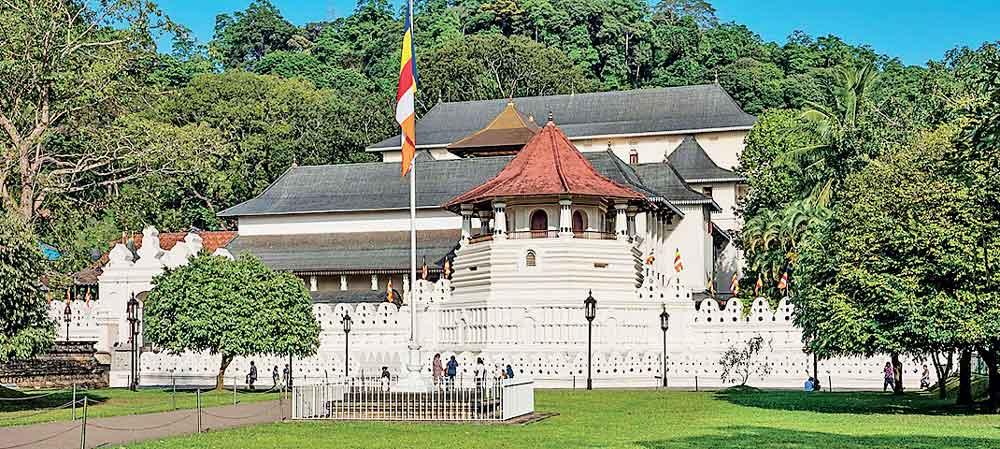Kandyan Convention, Buddhism, Brownrigg and Soulbury Reforms

The 1972 and 1978 Constitutions’ special provision for Buddhism was largely inspired by the 1815 Kandyan Convention, which placed the British Crown as the protector of Buddhism after taking over the Kandyan Kingdom
The Kandyan chiefs and the Mahanayake Theros agreed to the Kandyan Convention largely because it included provisions safeguarding their religion and privileges
Sri Lanka’s constitutional development spans over 180 years, beginning with the Colebrook-Cameron reforms of 1833
 The Kandyan Convention, an agreement between the British Colonial rulers and Kandyan chiefs, was signed in 1815. It annexed the Kingdom of Kandy to the British Empire, giving Britain full control over Ceylon. The Kandyan king was arrested and deposed. While the convention upheld local rights, rituals, and governance, it ensured that Kandyan laws and customs remained under native authorities. A unique feature was Article 5, which declared Buddhism inviolable, ensuring the protection of its rites, ministers, and temples. The Sinhala version also included provisions for the protection of Hindu temples (Devales). “The religion of Boodhoo… is declared inviolable, and its rites, ministries, and places of worship are to be maintained and protected.” This provision was designed to reinforce British authority over the Sasana.
The Kandyan Convention, an agreement between the British Colonial rulers and Kandyan chiefs, was signed in 1815. It annexed the Kingdom of Kandy to the British Empire, giving Britain full control over Ceylon. The Kandyan king was arrested and deposed. While the convention upheld local rights, rituals, and governance, it ensured that Kandyan laws and customs remained under native authorities. A unique feature was Article 5, which declared Buddhism inviolable, ensuring the protection of its rites, ministers, and temples. The Sinhala version also included provisions for the protection of Hindu temples (Devales). “The religion of Boodhoo… is declared inviolable, and its rites, ministries, and places of worship are to be maintained and protected.” This provision was designed to reinforce British authority over the Sasana.
Governor Brownrigg held discussions with Kandyan Buddhists regarding the convention and, on February 10, 1815, granted them a special audience. During this meeting, he personally assured them that Buddhism, along with its properties and places of worship, would be protected under British rule. However, the colonial authorities had no real intention of upholding these assurances.
Their primary goal was to pacify the Kandyan chiefs and gain the support of the high-ranking Buddhist clergy of the Malwatte and Asgiriya chapters by offering an appealing but ultimately ineffective guarantee. The Kandyan chiefs and the Mahanayake Theros agreed to the Kandyan Convention largely because it included provisions safeguarding their religion and privileges.
During Sri Lanka’s transition to independence in 1948, D.S. Senanayake, alongside constitutional expert Sir Ivor Jennings, helped draft the new constitution. However, the omission of Buddhism’s special status led to significant pressure from Buddhist clergy, including the prelates of the Asgiriya and Malwatta chapters, who threatened to boycott the Independence ceremony planned to be held in Kandy, unless their demands were met. Despite this, Senanayake remained firm in rejecting religious favoritism in the constitution of the newly independent nation.
Constitutional Evolution in Sri Lanka: A 180-Year Journey
Sri Lanka’s constitutional development spans over 180 years, beginning with the Colebrook-Cameron reforms of 1833. These were the first documented constitutional changes, designed primarily to serve British colonial interests rather than the aspirations of the local population. The reforms centralized administration and established the Executive and Legislative Councils, but they provided little room for native participation in governance.
In 1912, the Crewe-McCullum proposals sought to restructure the Legislative Council by introducing a team of advisers who were not elected representatives of the people. This approach maintained British dominance over governance, restricting indigenous political influence.
A major shift
Between 1921 and 1924, Governor Sir William Manning introduced a short-lived constitutional reform that aimed to increase native representation. However, the reforms were inadequate in addressing demands for greater self-rule. This was followed by Manning’s Local Government (LG) reforms, which governed Ceylon from 1924 to 1931, marking a gradual move toward self-administration.
A major shift came with the Donoughmore reforms of 1931, which introduced universal franchise, granting voting rights to all adults irrespective of ethnicity, caste, or gender. This was a radical departure from previous systems, which had limited political participation to elites. The State Council replaced the Legislative Council, creating a more representative form of governance. This period laid the groundwork for greater self-rule and was the final stage before full independence.
The Soulbury Constitution of 1947, named after Lord Soulbury and drafted by Sir Ivor Jennings, the first Vice-Chancellor of the University of Peradeniya, was a crucial step toward independence.
Under the guidance of D.S. Senanayake, the Leader of the House, this constitution established a parliamentary system that granted Dominion status to Sri Lanka, officially marking its transition from a British colony to an independent nation in 1948.
This long journey of constitutional evolution provides invaluable lessons for shaping an innovative and inclusive governance framework for the future.
DS and the Prelates’ Appeal
As Sri Lanka approached independence in 1948, the Buddhist clergy, led by the Mahanayake Theros of Malwatta and Asgiriya, urged the government to officially recognize Article 5 of the 1815 Kandyan Convention, which guaranteed state protection for Buddhism. They proposed the announcement be made during the Duke of Gloucester’s visit to Kandy in February 1948, symbolizing the continuation of the British Government’s commitment to Buddhism.
A warning was sent to the Government Agent that the Mahanayake Theros would boycott the Independence celebrations unless their demand for constitutional protection of Buddhism was included in the Independence Act. This demand was supported by key Kandyan figures who, despite their trust in D.S. Senanayake’s leadership, feared that future governments might not uphold Buddhism’s privileged status.
When the government invited the Mahanayake Theros and Diyawadana Nilame C.B. Nugawela for discussions at the Government Agent’s residence, the Diyawadana Nilame objected, insisting that the meeting be held at the Dalada Maligawa. Kandyan political groups also demanded assurances that the 1815 Kandyan Convention’s protections for Buddhism be included in the Order in Council.
At the Maligawa conference, attended by Mahanayakes, Anunayakes, and Kandyan representatives, D.S. Senanayake stood firm. He refused to visit the temples and instead met the Prelates at the Maligawa, arguing that constitutional favoritism for Buddhism contradicted the Dhamma’s principle of equality. His message was clear:
“If equality is a provision, then you cannot give primacy to one religion.”
Despite pressure, Senanayake ensured the 1948 Constitution upheld religious equality, avoiding the later entrenchment of Buddhism’s special status. His leadership, shaped by practical wisdom rather than academic theories, set him apart as a statesman of vision.
D.S. Senanayake, a Leader Beyond Religious Politics, a devout Buddhist though, never exploited Buddhism for political gain. Unlike later leaders, he refused to enshrine Buddhism’s primacy in the Constitution, believing that true protection of the faith did not require state intervention. His leadership, guided by Mettā, and Karuṇā was evident in Sri Lanka’s support for the Japanese Peace Treaty.
He foresaw that giving Buddhism special constitutional status could divide communities rather than unite them. His wisdom lay in prioritizing long-term national unity over short-term populism. Sri Lanka could have followed Myanmar’s example, where Clause 21.4 prohibits the political misuse of religion and criminalizes acts inciting religious or racial hatred. Had Sri Lanka followed a similar secular principle, it could have prevented the politicization of Buddhism and the dangerous fusion of religion and ethno-nationalist politics that has plagued the country since 1972.
Sirimavo Bandaranaike re-introduced it in 1972
In 1972, Sirimavo Bandaranaike sought to establish a Republican Constitution and consulted with Attorney General Victor Tennekoon and Solicitor General Rajah Wanasundera about religious protections. She directed them to draft a clause that would ensure the protection of Buddhism, mindful of the 1815 Kandyan Convention’s Article 5. Dr. Colvin R. de Silva, the architect of the constitution, famously remarked, “She is thrusting the Kandyan throne into our Constitution,” in response to the directive.
The 1972 and 1978 Constitutions’ special provision for Buddhism was largely inspired by the 1815 Kandyan Convention, which placed the British Crown as the protector of Buddhism after taking over the Kandyan Kingdom. However, adapting a colonial-era clause—which was a product of a vastly different historical context—into a modern democratic Constitution was a serious mistake.
Did Buddhism require constitutional protection between 1948 and 1972? Did the absence of such a clause weaken or harm Buddhism? The answer is no. Buddhism thrived in Sri Lanka before 1972 without any special constitutional status, proving that State intervention was unnecessary. Since 1972, however, the inclusion of Buddhism’s primacy in the Constitution has done more to divide the nation than to protect the religion.
If Sri Lanka truly seeks national unity, it must move away from outdated, divisive constitutional provisions. The priority should be bringing communities together, not reinforcing religious and ethnic divisions. DSS understood this. It is unfortunate that his successors, in their quest for political expediency, failed to follow his wisdom.
(Writer can be contacted at -kksperera1gmail.com)






